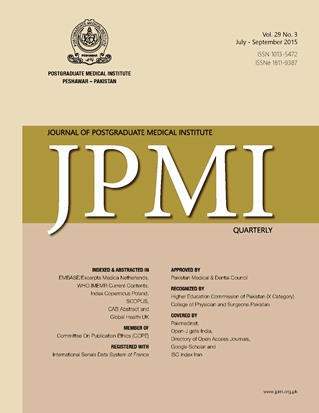EFFECT OF POVIDONE- IODINE IRRIGATION ON POST APPENDECTOMY WOUND INFECTION: RANDOMIZED CONTROL TRIAL
Main Article Content
Abstract
Objective: Despite the use of prophylactic antibiotics and sterilization tech -niques, rate of post appendicectomy wound infection is high. The usefulness
of povidone-iodine on intact skin is well-established but its use as prophy-lactic irrigation solution on open surgical wounds is limitedly addressed. This
study compare the frequency of superficial surgical site infection after appen -dicectomy, with and without peroperative irrigation of subcutaneous tissue
with 1% povidone-iodine solution.
Methods: A Total of 166 patients operated for acute appendicitis with open
appendicectomy at Civil Hospital Karachi were included in the study. They
were randomly allocated into two groups. In the treatment group, the subcu-taneous tissue was irrigated with 1% diluted povidone-iodine solution before
skin closure while no irrigation was done in the control group. All patients
were followed for surgical site infection according to Southampton wound
grading system for 30 days after surgery.
Results: The mean age of patients was 25.96±9.9 years with a male to female
ratio of 2:1. Wound healed normally with no signs of inflammation in 107
(64.5%) out of 166 patients. Mild bruising was present in 34(20.5%), erythema
with tenderness or heat in 11(6.6%) and serous/ haemoserous discharge in
6(3.6%) patients with no significant difference between the groups. Purulent
discharge was significantly reduced in the treatment group (p-value<0.05).
The overall infection rate was 10.8% and 19.3% in the treatment and control
group respectively (p=0.129).
Conclusion: The irrigation of the subcutaneous tissue with 1% diluted povi-done-iodine solution after appendicectomy, though not affect the overall in-fection rate but significantly reduced the formation of pus within the infected
wound cavity.
of povidone-iodine on intact skin is well-established but its use as prophy-lactic irrigation solution on open surgical wounds is limitedly addressed. This
study compare the frequency of superficial surgical site infection after appen -dicectomy, with and without peroperative irrigation of subcutaneous tissue
with 1% povidone-iodine solution.
Methods: A Total of 166 patients operated for acute appendicitis with open
appendicectomy at Civil Hospital Karachi were included in the study. They
were randomly allocated into two groups. In the treatment group, the subcu-taneous tissue was irrigated with 1% diluted povidone-iodine solution before
skin closure while no irrigation was done in the control group. All patients
were followed for surgical site infection according to Southampton wound
grading system for 30 days after surgery.
Results: The mean age of patients was 25.96±9.9 years with a male to female
ratio of 2:1. Wound healed normally with no signs of inflammation in 107
(64.5%) out of 166 patients. Mild bruising was present in 34(20.5%), erythema
with tenderness or heat in 11(6.6%) and serous/ haemoserous discharge in
6(3.6%) patients with no significant difference between the groups. Purulent
discharge was significantly reduced in the treatment group (p-value<0.05).
The overall infection rate was 10.8% and 19.3% in the treatment and control
group respectively (p=0.129).
Conclusion: The irrigation of the subcutaneous tissue with 1% diluted povi-done-iodine solution after appendicectomy, though not affect the overall in-fection rate but significantly reduced the formation of pus within the infected
wound cavity.
Article Details
How to Cite
1.
Iqbal M, Jawaid M, Qureshi MA, Iqbal S. EFFECT OF POVIDONE- IODINE IRRIGATION ON POST APPENDECTOMY WOUND INFECTION: RANDOMIZED CONTROL TRIAL. J Postgrad Med Inst [Internet]. 2015 Dec. 12 [cited 2026 Jan. 2];29(3). Available from: https://jpmi.org.pk/index.php/jpmi/article/view/1727
Issue
Section
Original Article
Work published in JPMI is licensed under a
Creative Commons Attribution-NonCommercial 2.0 Generic License.
Authors are permitted and encouraged to post their work online (e.g., in institutional repositories or on their website) prior to and during the submission process, as it can lead to productive exchanges, as well as earlier and greater citation of published work.


